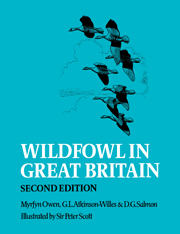Book contents
- Frontmatter
- Contents
- List of location maps
- Foreword by William Wilkinson
- Acknowledgements
- Conventions and abbreviations
- Part I Introduction
- Part II The survey of wildfowl habitat and distribution
- Introduction
- South-west England and southern Wales
- South and south-east England
- East and central England
- North-west England and North Wales
- Teesdale, Tyneside and the Borders
- North Cumbria and south-west Scotland
- South-east Scotland: Forth and Tay
- North-east Scotland
- North-west Scotland
- Part III Species accounts
- Part IV The conservation of wildfowl and their habitats
- Conclusion
- References
- Indexes
Introduction
Published online by Cambridge University Press: 04 August 2010
- Frontmatter
- Contents
- List of location maps
- Foreword by William Wilkinson
- Acknowledgements
- Conventions and abbreviations
- Part I Introduction
- Part II The survey of wildfowl habitat and distribution
- Introduction
- South-west England and southern Wales
- South and south-east England
- East and central England
- North-west England and North Wales
- Teesdale, Tyneside and the Borders
- North Cumbria and south-west Scotland
- South-east Scotland: Forth and Tay
- North-east Scotland
- North-west Scotland
- Part III Species accounts
- Part IV The conservation of wildfowl and their habitats
- Conclusion
- References
- Indexes
Summary
The data from the National Wildfowl Counts and the International Censuses have been used in many different ways in this book, the aim throughout being to furnish a sound scientific basis for the conservation of both birds and habitat. Their use to examine trends in numbers, to assess British populations and to map wildfowl distribution is described in Part III. Part IV discusses the ways in which counts are used to establish criteria for recognising sites of international importance and for assessing the value of individual areas in the national context.
The survey of wildfowl habitat and distribution which follows is concerned with the wetlands within each district, the populations of wildfowl occurring on them, and the changes which have taken place over the past 20–30 years. Apart from the sections written by the main authors, G.V.T. Matthews wrote “The Warwickshire Avon, middle Severn and Teme Basins”, “East and central England”, “North-west England”, and “Teesdale, Tyneside and the Borders” M. A. Ogilvie wrote “The inner Sol way Firth”, “Inland Dumfries”, “The Stewartry and Wigtown”, “The Clyde Basin” and “South-east Scotland”; M. Smart wrote “The lower Severn Vale”; and G.M. Williams and A. Henderson wrote “North Kent”.
The survey has been divided into nine chapters, corresponding to the principal water basins or “faunal regions”. The continued proliferation of man-made waters, often close to watersheds, has rendered the divisions between the regions less distinct than in the First Edition, but this is still considered the most logical system for a review of wildfowl distribution. The regional boundaries are shown in Fig 60 (p.339), and an enlargement of the appropriate part of this map is presented for each region.
- Type
- Chapter
- Information
- Wildfowl in Great Britain , pp. 26 - 28Publisher: Cambridge University PressPrint publication year: 1986



